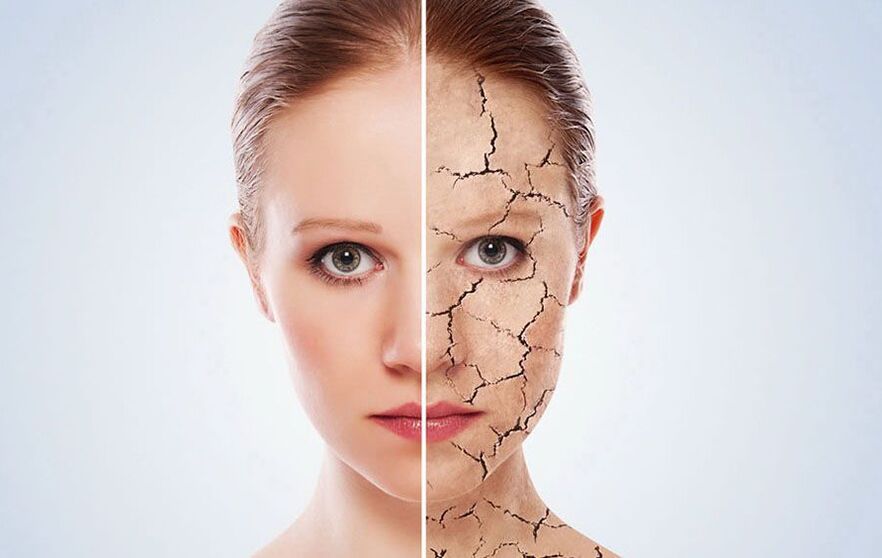
Who among us hasn't dreamed of inventing the "elixir of youth"? Because even the most spectacular and well-groomed 35-year-old lady already has noticeable crow's feet near her eyes and the first wrinkles on her forehead! And no matter how supportive nature may be, sooner or later you think about how to slow down the aging process of the facial skin and restore its former youth. Although human skin aging is not a disease, but a natural process, it is within our power to ensure the prevention of premature (early)Aging facial skin. Let's try to figure out how, why and when the skin ages. Read more about it in our article.
Signs of age-related skin changes
Unfortunately, every year you live leaves a mark not only on your memory, but also on your face. Typical signs of mature skin that needs anti-aging care are:
- Dryness and flaking: Over the years, the skin becomes dehydrated, thin and "parchment-like";
- Fold: at first superficial and barely noticeable, then more pronounced facial expressions and, most unpleasantly, deep ones;
- Reduced strength and elasticity: Facial features appear sharp or slack;
- Dullness: Even with proper care, the face loses its freshness over the years and looks tired;
- Dark spots, whose appearance is the final "wake-up call" that it is urgent to think about combating rapid skin aging.
The first signs of aging on the face do not appear at the age of 30 to 35, as most people think. Superficial wrinkles near the eyes and on the forehead begin to form at the age of 17-20, and their entire development cycle lasts up to 7-10 years!
Changes in the skin with increasing age
External signs of age-related changes are caused by natural internal processes. Over time in the skin:
- moisture content decreases, leading to a decrease in elasticity;
- Fewer collagen and elastin fibers are formed, which form an elastic "scaffolding" of the skin and prevent wrinkles from deepening.
- the renewal of surface layers deteriorates, causing the complexion to become duller and pores to appear enlarged;
- A "grouping" of pigment cells (melanocytes) occurs, which leads to pigment disorders.
Four types of facial skin aging
It's a big mistake to assume that aging skin always looks the same! Dermatologists and cosmetologists distinguish four main types of aging skin:
- Tired: with swelling, pasty consistency, pronounced nasolabial folds and drooping corners of the mouth;
- Wrinkled: with increased dryness, "crow's feet", wrinkled eyelids, "curled" upper lip and chin;
- Deformed: with a smoothed or "puffy" oval face, double chin, "bulldog" cheeks, excess fat in the eyelid area;
- Combined aging: with approximately equal severity of manifestations of the three previous types.
Although these signs appear only after 35-40 years, taking into account certain criteria, one can assume what type of aging will occur. Women with dry skin are more likely to develop pronounced wrinkles, and for women with a pronounced subcutaneous fat layer, it is important to make sure that the face does not "sag". If you have combination skin, aging will most likely follow the "tired" type.

Proper drinking regime, healthy diet, adequate sleep, quitting smoking and alcohol abuse, walks in the fresh air, physical exercise, a moderate rhythm of life and the use of high-quality cosmetics will undoubtedly slow down the aging of the facial skin of every woman.
How effective are anti-aging cosmetics?
Unfortunately, although leading cosmetic companies have their own laboratories and even beauty institutes, the effectiveness of expensive innovative anti-aging products is greatly exaggerated. Almost all creams, oils, masks, serums and other anti-aging products in the care of facial skin remain on the surface, without penetrating into the deeper layers, where the most important "age-related" changes take place!
Of course, for mature skin, a protective film with a UV filter makes sense, which prevents the evaporation of moisture and neutralizes the negative effects of sunlight. However, this does not affect the restoration of the elastic fiber frame in any way! In addition, claims about the collagen content of a cream in most cases turn out to be a banal advertising ploy, since, according to British scientists, this high-molecular protein is simply not able to penetrate the skin barrier.
At the same time, timely contact with a specialist in the field of aesthetic cosmetology allows you to achieve radical "rejuvenation" without plastic surgery. And now we invite you to familiarize yourself with the most effective procedures for "early" recovery.
Method number 1. Moisturizing
Hints: Tired skin and combined aging, although as a complementary method, moisturizing is also effective for wrinkles.
The best professional solution: Biorevitalization with hyaluronic acid.
Application point: Deep layers of skin. Since the content of hyaluronic acid decreases with age, the injection allows you to saturate the skin with moisture and stimulate the production of your own hyaluronic acid, collagen fibers and elastin.
Results: The face looks firmer and fresher, the color is evened out and the severity of age spots is noticeably reduced.
Method number 2. Fight wrinkles
Hints: Wrinkled skin.
Professional solution #1: Plastic surgery of the injection contour.
Application point: Middle and deep layers of skin. Special biocompatible fillers are injected with a thin needle directly under the fold (crease) or into the muscle under the problem area to create the required volume.
Results: The extra volume smoothes wrinkles and makes them less noticeable.
Professional solution #2: fractional laser
Application point: Deep layers of skin. Distributed laser beams penetrate 0. 4. . 1. 4 mm deep and stimulate the production of collagen and elastin fibers.
Results: Restoring your own fibrous structure reduces the severity of medium and deep wrinkles and makes superficial wrinkles almost invisible. Further effects of fractional thermolysis include the disappearance or significant lightening of age spots and a tightening of the facial contour.
Professional solution #3: Botox or Dysport injections.
Application point: facial muscles. The action of botulinum toxin, the main component of these drugs, leads to the relaxation of the facial muscles and thus the smoothing of wrinkles.
Results: Reduces the number and severity of visible wrinkles, especially as the skin around the eyes ages.
Method number 3. Restoration of facial contours
Hints: Aging with sagging skin.
Professional solution: Thread lifting (thread lifting).
Application point: Deep layers of skin. By inserting the finest threads, problem areas (eyes, eyebrows, cheeks, chin, neck, etc. ) are tightened and supported. Another benefit of the procedure is stimulating the production of your own collagen, making the resulting framework more durable.
Results: Noticeable tightening of sagging areas, improvement of contours.
Method number 4. "Renewal" of the skin
Hints: Combined aging.
Professional solution: Peeling: laser and chemical.
Application point: Superficial, middle and deep layers of the epidermis. The "evaporation" of keratinized epithelium under the influence of a laser beam or its removal with organic acid stimulates the growth of new cells and the restoration of collagen fibers.
Results: Using a peeling on aging skin leads to a noticeable rejuvenation effect: the face appears fresher and over time, by strengthening the collagen structure, wrinkles are smoothed and the contour is tightened.
In conclusion, it is worth noting that a specialist in the field of aesthetic cosmetology will select the best method for you to eliminate wrinkles and prevent further skin aging, taking into account the type of aging and your individual characteristics.
























































